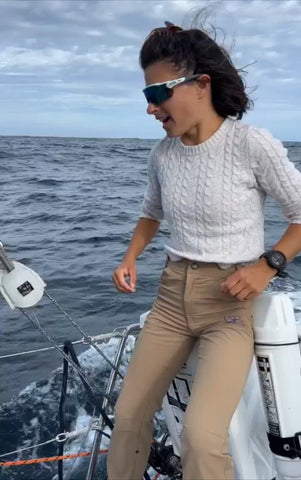
We Wear the Pants: A History of Empowerment in Women’s Fashion (and Where Gnara Apparel Comes In!)
Women's History Month
Pants are more than pieces of apparel; they’re political statements, straight from the seams of rebellion, sewn into symbols of empowerment. For Women’s History Month, we’re delving into the history of why We Wear the Pants.

CEO & Co-Founder Georgia Grace (GG) rocking our WWTP tee
While the earliest known examples of trousers date back to 3000 BC – variations of which have been worn by men for several millennia* – pants have only been an “acceptable” everyday clothing option for women in Western society for a couple decades. When we consider the brief timeline below (which will almost certainly blow your mind), it’s apparent that the women’s pant industry in the US in particular is extraordinarily young, which explains why we haven’t seen much innovation in this space until now.
Let’s unzip some American history:
1850s
In 1851, Elizabeth Smith Miller introduced what became known as bloomers – the first pants-like clothing for women, to New York. The initial designs consisted of a short jacket on top, paired with a knee-length skirt, which partially covered up loose “Turkish” pantaloons inspired by a trip to Europe. This garment got its name from Amelia Bloomer, who was the editor of the first newspaper for women, The Lily, and regularly wore the baggy trousers that gathered at the ankle in her many speaking appearances in New York City.
Other early advocates of bloomers included revolutionary women like Mary Edwards Walker, the first female surgeon in field duty during the Civil War, as well as Elizabeth Cady Stanton, leader in the American women’s rights and suffrage movements.
Despite the popularity bloomers gained during this era of social reform, the innovation stirred up significant controversy, wearers were publicly ridiculed, and women resorted to wearing them only while riding bicycles or doing other forms of exercise, or in the privacy of their homes.
 "The Bloomer 'Costume'" drawing via Library of Congress
"The Bloomer 'Costume'" drawing via Library of Congress
1910s
1930s

1940-50s
1960s-70s

1990s
Despite the progress of the Women’s Liberation Movement, it wasn't until three decades later – 1993 – that women were permitted to wear pants on the floor of the U.S. Senate! This change came after Senator Barbara Mikulski of Maryland, along with a group of female senators, pushed for a revision of the Senate dress code, which previously required women to wear skirts or dresses. Hillary Clinton became the first woman to wear trousers in an officially American First Lady Portrait.
2000s
Even in the 21st century, examples of unequal treatment regarding women's attire persist, including discriminatory dress codes in schools and workplaces, unequal scrutiny of female athletes' clothing choices in sports, and expectations of adherence to traditional dress codes in certain cultures and religions, all of which hinder women's autonomy and reinforce gender stereotypes. Not to mention the lack of functional, fashionable options for women’s outdoor apparel, which is where we come in.
2010s
Our mission is to remove these barriers by redefining women’s apparel and challenging the status quo through our apparel. We took the TED Talk stage to discuss the intersection of women's empowerment and fashion, highlighting the historical significance of pants as symbols of liberation and autonomy. We have a vision to empower women, embrace boldness, and proudly claim our autonomy and anatomy.
For all those reasons and 1,000 more: We Wear the Pants.
Cole aboard her boat, named 'First Light,' in our Badlands Beige color way.
Know a woman doing bada$$ stuff in our Go There Pants or other products featuring our patented GoFly Zipper Technology? We wanna know, and feature them!
Tell us in the comments!
---------------------------------------------------------------------------------------------
Sources:
- Wikipedia - Trousers
- Britannica - Women & Pants
- Britannica - Bloomers
- National Park Service - Elizabeth Smith Miller
- Britannica - Amelia Bloomer
- National Park Service - Amelia Bloomer
- Britannica- Elizabeth Cady Stanton
- Britannica - Mary Edwards Malker
- Britannica - Women's Liberation Movement
- Science News Explores - Oldest Pants
- The Archeologist - Invention of Trousers
- Snopes - Woman Jailed for Wearing Slacks
- PBS - Women's Advances in Congress




